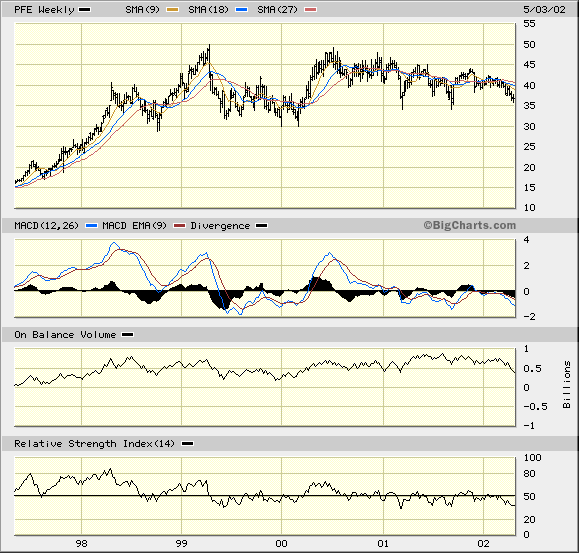Recovery
May Not Be as Expected
Monday,
May 06, 2002
The
North American markets continue to trade on a negative bias. The
NASDAQ continues to weaken far greater than the other indices
on the basis of weak economic evidence of a recovery.
It
remains difficult to forecast a recovery in business spending
for I.T. Corporations continue to monitor expenses very carefully.
As a result, technology companies are having difficulty growing
revenue. At best, the sector can hope for stable to slightly declining
growth. From a market perspective, the largest tech firms (IBM,
Microsoft, Oracle, Intel, and Sun Microsystems) are trading at
or making new 52-week lows. Emerging bell-weathers (SAP, Peoplesoft,
Veritas Software, Brocade Communications) are faring much worse.
If
we take a step back from the trading action to evaluate the prospects
of the Nasdaq, it is clear that the risk/reward for investors
remains very poor. In addition, the tech firms continue to trade
with a substantial growth premium, even though we cannot expect
such rates to continue – at least in the short term. Therefore,
as economic evidence continues to border on muted growth, making
money on trading Nasdaq stocks will be a strategy based on selective
and short-term positioning.
Another
ominous cloud looming for tech stocks is the push by Alan Greenspan
to include stock options as expenses. Greenspan pointed out that
profits over the past few years would be reduced by about 2.5%
if options were included. While the Enron accounting fiasco has
fueled an eye for scrutiny regarding options, the issues will
most likely continue to add to negative pressure on expensive
stocks.
Pharmaceutical
stocks, once perceived as “safe havens” in times of uncertainty,
are also trading as poorly as tech stocks. Fundamental issues
are likely to keep the big cap stocks down. Big-name patents,
which are the bread and butter for stable revenue growth for firms,
are expiring for Merck and Brystol Myers. In addition, competitive
pressures are or will be eating away at profits for Pfizer’s Viagra.
With such negative news continually pushing pharmaceutical stocks
down, it may be highly profitable to look for an entry point for
stocks getting hit by association.

From
a valuation perspective, I like Pfizer if it is in the range of
$31-$34. Despite competitive pressures for some of its products,
Pfizer has a broader portfolio of products and the company therefore
deserves to trade at a higher premium than its peers. Brystol
Myers and Schering-Plough Corporation ( are at or near 52-week
lows. From a “value” perspective, these stocks represent short-term
trading opportunities. They are likely to rebound at greater rates
than the sector and broader indices.

The
big firms are also undergoing pricing pressure from the government,
who feel that insurance companies should receive volume discounts.
Therefore, “smaller”-cap pharmaceuticals (relative to the market
leaders) might be better investments for the long term because
they do not face the same deterioration in pricing. They also
represent good trading opportunities. ICOS and QLT Phototherapeutics
are potential trading stocks, although the risk remains high.
Of
the stocks listed above, BMY, MRK SGP, and QLT have been in a
bear trend for quite some time. Therefore, a long-term trading
position may actually be riskier than trading on short-term bounces.
Unless there are fundamental improvements for these companies,
the trading time horizon should remain short.
The
telecom sector takes by far the biggest piece of the bear-market
sentiment. Equipment makers such as Lucent and Nortel continue
to live up to “write-off.” Their customers, Worldcom, BCE (Teleglobe),
SBC, AT&T and Verizon have cut off CapEx (capital expenditures)
for 2002. Bankrupt firms (Global Crossing, Williams Communication
and 360 Networks), even though they have restructured, have much
less to spend. One could list the customers who themselves are
having a tough time growing revenue in a space where prices are
declining. The list would be pretty much all telecom providers.
It is clear that consolidation must take place among these
firms. Until that happens, it is best to avoid all telecom and
telecom-related firms.
It
appears the only area holding up well is resource sector. While
oil, metal, and gold prices have increased (for the most part),
it is a sector that investors should be accumulating aggressively.
During the late 1990’s as metal prices fell, these firms reduced
their operating costs substantially. Many firms also merged to
realize cost savings and to control output (and therefore reduce
pressure on prices). These actions have yet to occur in the sectors
outlined above. My picks are Alcan Aluminum, Inco Ltd, and Barrick
Gold.
|

